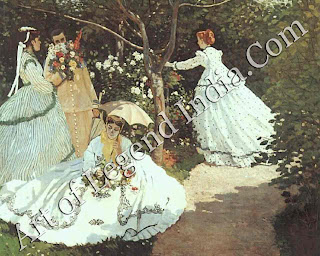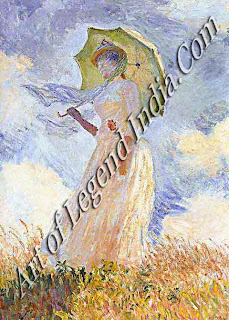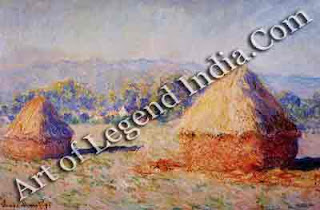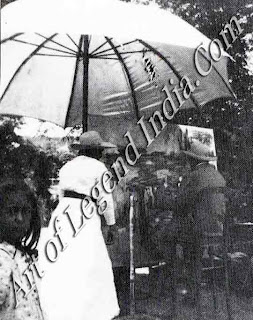The Fleeting Impression
Monet
painted in the open air with a speed and fervour no earlier artist had
approached. But as he grew older, he saw the need to work more in his studio,
to refine and perfect his paintings.
Monet
is often considered the greatest and most typical of the Impressionists. This judgment
reflects not only the quality of his work, but also his wholehearted dedication
to the ideals of Impressionism throughout his mature -fife. In particular, he
was committed to the Impressionist practice of painting out of doors. This in
itself was not new, but Monet made it an article of faith.
None of
his predecessors had worked out-of-doors to the same ambitious scale. In the
early 19th century, for example, John Constable had often made sketches in oils
outdoors, but only as preparatory studies for larger paintings. And Boudin and
Jongkind, the two artists who had the most important influence on Monet's early
work, also worked on a fairly small scale. Monet differed from these painters
both in his conviction and in his ambitions. He made outdoor painting not just
a basis for further elaboration, but the central feature of his huge output.
 Monet's
declared aim was to catch the passing impressions of light and atmosphere, 'the
most fleeting effects', as he called them, and in his dedication to this goal
he took measures that often had an element of farce about them. In 1866-7 he
painted one of his most famous works, Women in the Garden, a canvas more than
eight feet high, and to enable him to paint all the picture out-of-doors, he
had a trench dug so the canvas could be raised or lowered by pulleys to the
required height.
Monet's
declared aim was to catch the passing impressions of light and atmosphere, 'the
most fleeting effects', as he called them, and in his dedication to this goal
he took measures that often had an element of farce about them. In 1866-7 he
painted one of his most famous works, Women in the Garden, a canvas more than
eight feet high, and to enable him to paint all the picture out-of-doors, he
had a trench dug so the canvas could be raised or lowered by pulleys to the
required height.
Much
later in his career, when he was working on a series of paintings such as his
Haystacks, his step-daughter Blanche Hoschede-Monet used a wheelbarrow to carry
his unfinished paintings around the fields with him; when the light changed
perceptibly, Monet would switch to another canvas that matched the new
conditions.
BRAVING THE ELEMENTS
 Bad
weather did not weaken his determination to capture the effects he wanted. One
observer described him working on the Normandy coast in 1885: With water
streaming under his cape, he painted the storm amid the swirl of the salt
water. He had between his knees two or three canvases, which took their place
on his easel one after another, each for a few minutes at a time. On the stormy
sea different light effects appeared. The painter watched for each of these
effects, a slave to the comings and goings of the light, laying down his brush
when the effect was gone, placing at his feet the unfinished canvas, ready to
resume work upon the return of a vanished impression.
Bad
weather did not weaken his determination to capture the effects he wanted. One
observer described him working on the Normandy coast in 1885: With water
streaming under his cape, he painted the storm amid the swirl of the salt
water. He had between his knees two or three canvases, which took their place
on his easel one after another, each for a few minutes at a time. On the stormy
sea different light effects appeared. The painter watched for each of these
effects, a slave to the comings and goings of the light, laying down his brush
when the effect was gone, placing at his feet the unfinished canvas, ready to
resume work upon the return of a vanished impression.
Such
accounts of Monet at work part-heroic, part-absurd illustrate what he and the
other Impressionists found was the greatest drawback to their new approach to
painting: the effects in nature change so quickly that the more sensitive air
artist is to them, the less time he can spend on a picture before any
particular effect has gone. Referring to his haystack series in October 1890,
Monet wrote: 'I really am working terribly hard, struggling with a series of
different effects, but at this time of year the sun sets so quickly that I
can't keep up with it.' To overcome this problem Monet began to work more and
more in the studio to re-touch or revise his paintings. But publicly he liked
to maintain his image as an outdoor painter.
PAINTING AT SPEED
 Monet
developed a free and spontaneous painting technique which enabled him to work
at speed. His brushwork is remarkably flexible and varied, sometimes broad and
sweeping, sometimes fragmented and sparkling. Occasionally he used the handle
of the brush to scratch through the paint surface and create a more broken,
textured effect. His last paintings, the great series representing the
waterlilies in his garden at Givemy, were executed more slowly than his earlier
works and many of them have a richly encrusted surface, the paint dragged and
superimposed, layer upon shimmering layer.
Monet
developed a free and spontaneous painting technique which enabled him to work
at speed. His brushwork is remarkably flexible and varied, sometimes broad and
sweeping, sometimes fragmented and sparkling. Occasionally he used the handle
of the brush to scratch through the paint surface and create a more broken,
textured effect. His last paintings, the great series representing the
waterlilies in his garden at Givemy, were executed more slowly than his earlier
works and many of them have a richly encrusted surface, the paint dragged and
superimposed, layer upon shimmering layer.
Paul
Cezanne, a landscape painter of equal stature, declared that Monet was 'only an
eye, but, my God, what an eye!' Many of Monet's own observations seem to bear
out that this was the way he thought of himself. He told a pupil that 'he
wished he had been born blind and then suddenly regained his sight, so that he
would have begun to paint without knowing what the objects were that he saw
before him'. And he advised 'When you go out to paint, try to forget what
objects you have in front of you, a tree, a field,.. Merely think, here is a
little square of blue, here an oblong of pink, here a streak of yellow, and
paint it just as it looks to you, the exact colour and shape, until it gives
your own naive impression of the scene.'
But no
artist simply reproduces what he sees in front of him, and although Monet might
strive to be objective, he was never impersonal. His increasing reliance on
studio work shows that he realized that his art consisted not merely in
observing and recording, but in finding a pictorial equivalent in opaque paint
on a two-dimensional surface for the infinitely varied effects of light. And as
with all great art, there is a dimension to Monet's work that ultimately evades
analysis or explanation. His great series of waterlily paintings, in
particular, are the product not simply of an exceptionally keen eye and an
unerring hand, but also of a poetic spirit.
Writer
– Marshall Cavendish
 Monet's
declared aim was to catch the passing impressions of light and atmosphere, 'the
most fleeting effects', as he called them, and in his dedication to this goal
he took measures that often had an element of farce about them. In 1866-7 he
painted one of his most famous works, Women in the Garden, a canvas more than
eight feet high, and to enable him to paint all the picture out-of-doors, he
had a trench dug so the canvas could be raised or lowered by pulleys to the
required height.
Monet's
declared aim was to catch the passing impressions of light and atmosphere, 'the
most fleeting effects', as he called them, and in his dedication to this goal
he took measures that often had an element of farce about them. In 1866-7 he
painted one of his most famous works, Women in the Garden, a canvas more than
eight feet high, and to enable him to paint all the picture out-of-doors, he
had a trench dug so the canvas could be raised or lowered by pulleys to the
required height.  Bad
weather did not weaken his determination to capture the effects he wanted. One
observer described him working on the Normandy coast in 1885: With water
streaming under his cape, he painted the storm amid the swirl of the salt
water. He had between his knees two or three canvases, which took their place
on his easel one after another, each for a few minutes at a time. On the stormy
sea different light effects appeared. The painter watched for each of these
effects, a slave to the comings and goings of the light, laying down his brush
when the effect was gone, placing at his feet the unfinished canvas, ready to
resume work upon the return of a vanished impression.
Bad
weather did not weaken his determination to capture the effects he wanted. One
observer described him working on the Normandy coast in 1885: With water
streaming under his cape, he painted the storm amid the swirl of the salt
water. He had between his knees two or three canvases, which took their place
on his easel one after another, each for a few minutes at a time. On the stormy
sea different light effects appeared. The painter watched for each of these
effects, a slave to the comings and goings of the light, laying down his brush
when the effect was gone, placing at his feet the unfinished canvas, ready to
resume work upon the return of a vanished impression.  Monet
developed a free and spontaneous painting technique which enabled him to work
at speed. His brushwork is remarkably flexible and varied, sometimes broad and
sweeping, sometimes fragmented and sparkling. Occasionally he used the handle
of the brush to scratch through the paint surface and create a more broken,
textured effect. His last paintings, the great series representing the
waterlilies in his garden at Givemy, were executed more slowly than his earlier
works and many of them have a richly encrusted surface, the paint dragged and
superimposed, layer upon shimmering layer.
Monet
developed a free and spontaneous painting technique which enabled him to work
at speed. His brushwork is remarkably flexible and varied, sometimes broad and
sweeping, sometimes fragmented and sparkling. Occasionally he used the handle
of the brush to scratch through the paint surface and create a more broken,
textured effect. His last paintings, the great series representing the
waterlilies in his garden at Givemy, were executed more slowly than his earlier
works and many of them have a richly encrusted surface, the paint dragged and
superimposed, layer upon shimmering layer.











0 Response to " French Great Artist Cloud Monet - The Fleeting Impression"
Post a Comment